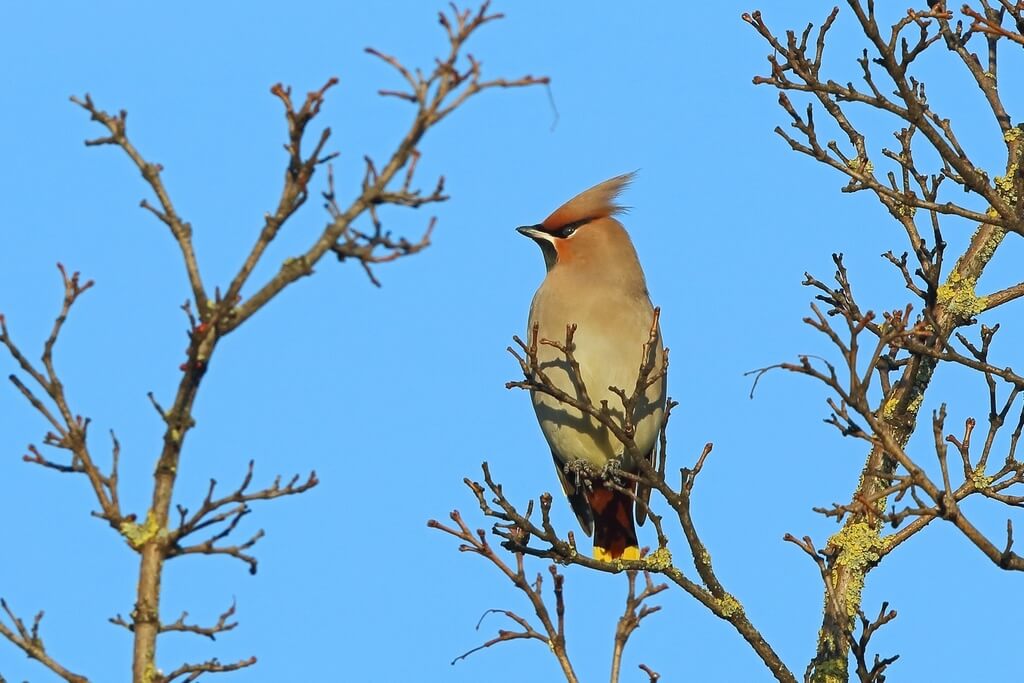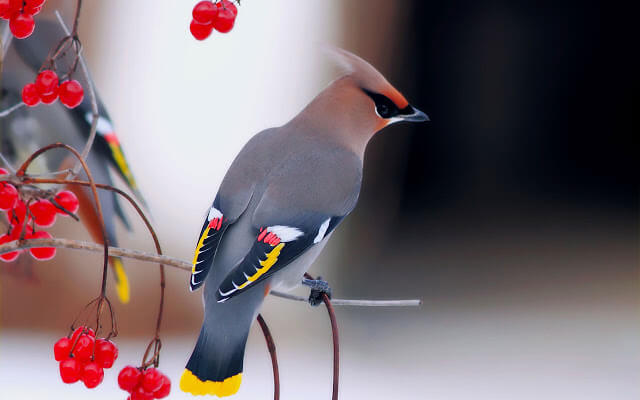Bohemian Waxwing: Habitat, Characteristics and Reproduction

The Bohemian waxwing is a very distinctive and beautiful bird. It lives in Europe, but also extends to the Holarctic region – parts of Asia and North America. Scientifically it’s known as Bombycilla garrulus and it certainly leads an interesting life. Would you like to find out all about it?
It belongs to the order Passeriformes and the family Bombycillidae, which includes two other species, grouped in the same genus Bombycilla, the Japanese waxwing and the American waxwing. In this article, we’ll bring you a complete guide to this lovely bird. So, do not miss anything about its habitat, characteristics, feeding, reproduction, and conservation status.
Habitat of the Bohemian waxwing
As we have already mentioned, this bird has a wide distribution, because it’s a holarctic species. It can be found in northern Eurasia, from the Atlantic Ocean to the Pacific, as well as in northern North America.
The habitat of this species is variable, based on the time of year and its geographic location. On the one hand, during the mating season, it can be seen in boreal forests of conifers, spruces, pines, and other types of trees, even in mixed areas. It prefers regions with abundant water and food, so it likes to spend time near lakes, streams, and marshes.
On the other hand, the most diverse spaces are found during the non-breeding season, as long as fruiting plants and some trees are present. These habitats include urban places, such as footpaths, gardens, or cultivated areas.
Bohemian waxwing characteristics

This flycatcher has a plumage between brown, gray and reddish, with a chestnut color on its face. It has a short tail, which ends in a yellow stripe, with a dark border on the upper part. It has a black band over its eyes and throat of the same color.
In addition, the wings have a distinctive design, and they’re more colorful than the rest of the body. The flight feathers are black, the primary feathers have white and yellow spots, and the tips of the secondary feathers are red.
It measures about 20 centimeters (8 inches) and weighs between 46 and 70 grams (1.6 to 2.5 oz). Its wingspan is around 30 to 36 centimeters (12 to 14 inches). It has a short black beak. When young it has a more grayish plumage and a white throat.
Males and females have some differences in their appearance. Male individuals have a larger throat patch, as well as a yellow tip on their tail feathers. Another characteristic is that they have more distinctive designs on their wings than the female.
The Bohemian waxwing has an elegant appearance, thanks to the crest on its head and the soft, silky appearance of its feathers – it is, indeed, a very beautiful specimen.
Subspecies
As we have already briefly mentioned, there are three types or subspecies of these waxwings in the world. We have the following:
- Bombycilla Garrulus Garrulus Garrulus, located in Europe
- B. Garrulus Centralasiae, which inhabits Asia
- B. Garrulus Pallidiceps, found in North America.
Behavior
They’re diurnal birds with arboreal habits, although they can be observed on rare occasions walking on the ground. They keep their plumage nice and clean by constant preening. They also bathe in puddles left by the rain.
They’re social birds that fly in groups while searching for food. In addition, they’re partial migrants, traveling in large flocks of up to 300 individuals.
Another important characteristic is that it isn’t a territorial bird. In fact, the only evident sign of aggression is to protect its mate during the breeding season, to prevent other males from conquering it. Thus, it can adopt a threatening posture and attack with its beak.
Likewise, these birds emit calls relevant to social cohesion. They also make specific sounds in courtship, nest building, and egg incubation.
The Bohemian waxwing is an omnivorous bird that consumes both animals and plants, according to the availability in its environment, location and season of the year. However, it’s identified as a specialist for frugivorous nutrition, at least temporarily, despite the fact that fruits don’t provide enough protein, which they solve by ingesting large quantities.
Among these fruits, we can mention blueberries, berries, junipers, apple trees and other varieties, based on location and season. They also include insects and other animals in their diet, such as spiders and snails. They capture some insects in flight.
In relation to water, they need to consume large quantities to avoid being intoxicated by the ethanol produced during the metabolism of sugars. This is especially the case in the winter season, when the available fruits are less juicy, as opposed to the summer season.
Reproduction
This passerine breeds sexually once a year, between the months of March and June, depending on its geographical location. Courtship behavior includes leaping approaches and gifts (food or objects). It can lay between 3 and 7 eggs. These are smooth and shiny, oval or nearly elliptical in shape, and grayish or bluish in color with black dots and lines.
The cup-shaped nest is constructed of twigs and other materials (plant and animal). These include mosses, lichens, grasses, feathers, and skins. The bird places it on trees 1.5 to 9 meters high (3.3 to 30 feet).
The mother incubates the eggs alone for approximately 13 days. However, the father joins in to feed the young after hatching.
Conservation status of the Bohemian waxwing

Thanks to its wide distribution range, both in the Old and New World, this species of waxwing isn’t endangered. The International Union for Conservation of Nature classifies it in the category of Least Concern. The population density is estimated to be increasing.
Thus, the Bohemian waxwing is a very distinctive bird, with its soft and beautiful plumage. However, apart from its beauty, it brings benefits to the ecosystem by allowing the dissemination of the seeds of the plants it consumes. A valuable task for the natural regeneration of forests.
All cited sources were thoroughly reviewed by our team to ensure their quality, reliability, currency, and validity. The bibliography of this article was considered reliable and of academic or scientific accuracy.
- Berthold. P. (1976). Der Seidenschwanz Bombycilla garrulus als frugivorer Ernährungsspezialist. Experientia, 32(11), 1445–1445.
- BirdLife International. (2016). Bombycilla garrulus. The IUCN Red List of Threatened Species 2016: e.T22708146A87399543.
- Karatas, A., Bulut, S., & Karatas, A. (2019). New distribution records of Bohemian Waxwing Bombycilla garrulus (Linnaeus, 1758) from Turkey. Biharean biologist, 13(1), 58-59.
- Noval, A. (1966). Crónica de historia natural del país vasco. 65 Breve reseña del ampelis europeo (Bombycilla garrulus). Munibe, XVIII, 224-226. Recuperado el 01 de enero de 2022, disponible en: http://www.aranzadi.eus/fileadmin/docs/Munibe/1966224226.pdf
- Rawal, R., Abhinav, C., & Sharma, M. (2017). Bohemian Waxwing Bombycilla garrulus at Rualing, Lahaul, Himachal Pradesh: A second record for India. Indian BIRDS, 13(5), 133–135.
- Wilson, C. (2009). Bombycilla garrulus. Animal Diversity Web. Recuperado el 01 de diciembre de 2022, disponible en: https://animaldiversity.org/accounts/Bombycilla_garrulus/
This text is provided for informational purposes only and does not replace consultation with a professional. If in doubt, consult your specialist.